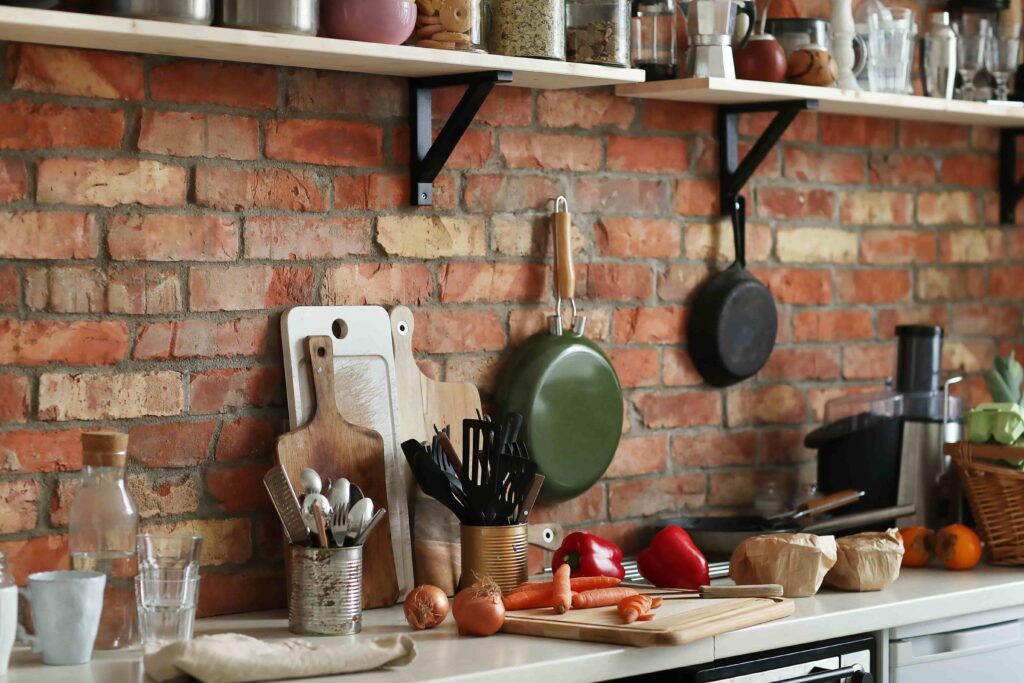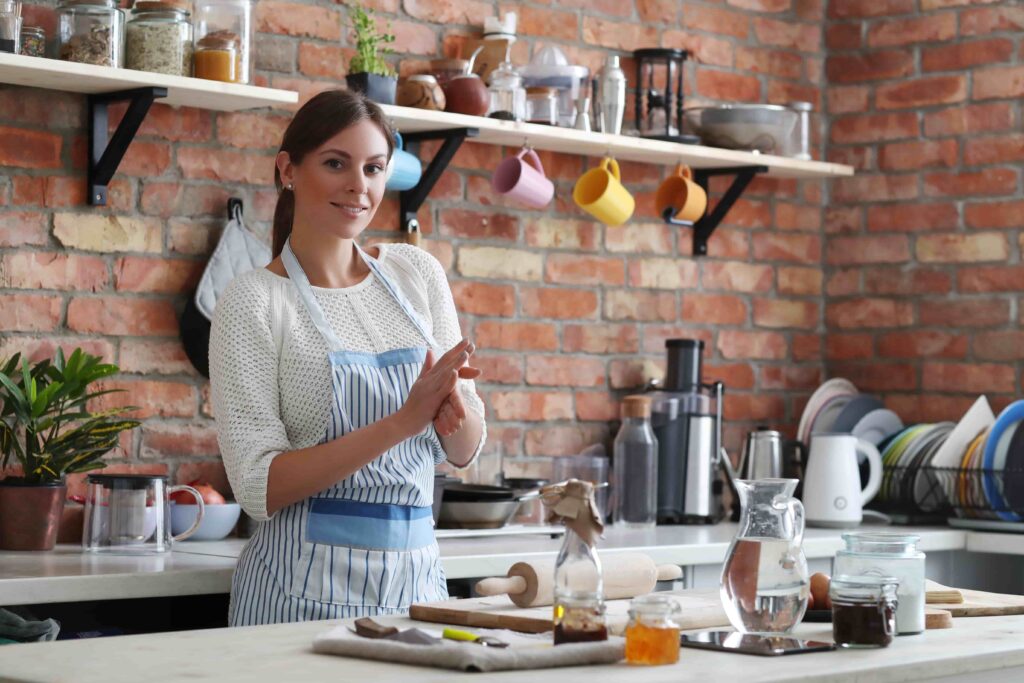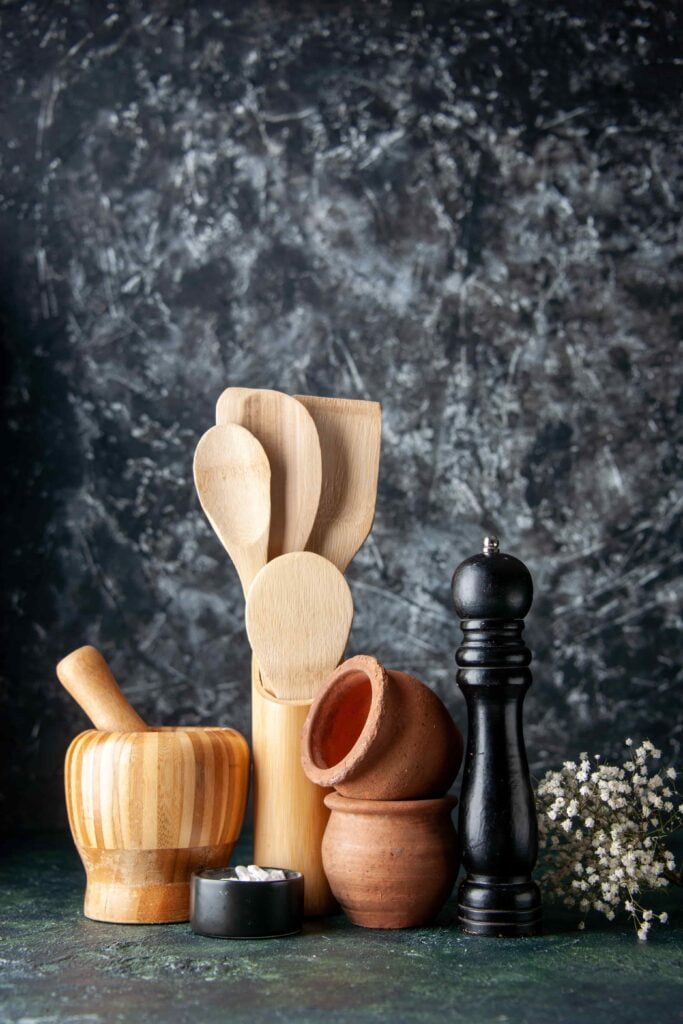Introduction
A well-equipped kitchen is crucial to efficient, enjoyable cooking. Quality equipment saves time, increases versatility and promotes measurement accuracy. With the right kitchen accessories, you can unleash creativity, enhance presentation, and make cooking a comfortable, enjoyable experience. Whether you’re an experienced chef or a novice, investing in a well-equipped kitchen is an investment in the joy and satisfaction of your culinary journey.
Kitchen accessories play an important role in enhancing the cooking experience by promoting efficiency, precision and versatility. Sharp knives and quality cookware save time, while measuring tools ensure accurate results. Versatile gadgets inspire creativity and ergonomic designs create a comfortable cooking environment. Stylish presentation tools compliment the process, encouraging culinary exploration. In essence, these accessories transform cooking into an enjoyable, efficient and creative journey.

Knife Set
The importance of a quality knife set in the kitchen is crucial for efficient and enjoyable cooking. Let’s get into the details:
Accuracy and control: A quality knife set ensures precision in slicing, cutting and slicing. Sharp, well-made blades provide better control over the cutting process, allowing for clean and precise cuts. Precision is especially important when working with delicate ingredients or when aiming for the consistent size of vegetables, meat or other food items.
Job Versatility: A comprehensive knife set includes a variety of knives designed for specific tasks. This versatility allows you to tackle a wide range of ingredients and cooking techniques. For example, a chef’s knife is great for simple slicing, a serrated knife works well for bread, and a paring knife is ideal for complex tasks like peeling and trimming.
Skills in food preparation: Quality knives reduce the effort required in food preparation. Sharp blades cut through ingredients effortlessly, saving time and energy in the kitchen Efficient knives contribute to a smoother workflow, making the overall cooking process more enjoyable and less stressful.
Durability and Longevity: Investing in a quality knife set often means investing in durable materials and construction. High-quality blades made from stainless steel or other premium materials are less prone to corrosion and damage. Proper care, such as regular sharpening and hand washing, can extend the life of knives, making them a long-term investment for your kitchen.
Professional cooking experience: A quality knife set provides a professional cooking experience, used by restaurant chefs. It can boost your confidence in the kitchen and encourage you to experiment with advanced cooking techniques. Professional-grade knives contribute to the overall aesthetic of your food, enhancing the presentation of your culinary creations.
Improving cooking skills: Using a quality knife set can improve your knife skills and overall efficiency in the kitchen. As you become more comfortable and skilled with your knives, you will be able to perform complex cuts and maneuvers with precision. Enhanced knife skills not only contribute to better-looking food but also make the cooking process more enjoyable and satisfying.
Different types of knives and their specific uses involve highlighting the unique characteristics of different knife styles and explaining how they are best suited for specific kitchen tasks. Here is a detailed explanation:
Chef’s Knife: Features: A versatile, all-purpose knife with a broad, tapered blade. Specific Uses: Ideal for cutting, slicing, dicing and mincing. Its curved blade allows for an oscillating motion, making it suitable for a wide range of materials.
Pruning Knife: Characteristics: A small, pointed knife with a narrow blade. Specific Uses: Suitable for precision tasks such as peeling, trimming and detail cutting. Small fruits and vegetables are easy to work with.
Serrated Knife (Bread Knife): Features: Long, narrow blades with a jagged edge. Specific Uses: Designed for slicing rather than crushing bread. Also useful for delicate items like tomatoes and cakes.
Utility Knife: Characteristics: A medium-sized knife with a narrow and straight or slightly curved blade. Specific Uses: Versatile for a variety of cutting tasks, often used for cutting sandwiches, small fruits and vegetables.
Boning Knife: Features: Features a thin, flexible blade with a fine tip. Specific Uses: Designed to remove bones from meat, poultry and fish. Blade flexibility allows for precision in tight spaces.
Filling knife: Features: Long, thin and flexible blades. Specific Uses: Ideal for fish filleting, poultry deboning and skin removal. The flexibility of the blade becomes fleshy.
Cleaver: Features: A large, heavy knife with a wide, rectangular blade. Specific Uses: Primarily used for boning and tough cuts of meat. Also suitable for crushing garlic or ginger.
Santoku Knife: Characteristics: A Japanese knife with a short, broad blade and a flat cutting edge. Specific Uses: Great for slicing, dicing and cutting. The flat edge is perfect for precise downward cuts.
Steak Knife: Features: Has a serrated or straight edge like a utility knife. Specific Uses: Used on the dining table for cutting cooked meats. Serrated edge maintains sharpness for clean cuts.
Carving Knife: Features: A long, narrow blade with a pointed tip. Specific Uses: Designed for thin, precise cuts of cooked meats, such as roasts, poultry or hams.
Cutting Boards
The necessity of good cutting boards involves highlighting the crucial role they play in the kitchen for both food safety and the longevity of your knives.
Food Safety: Non-porous surface: Good cutting boards are usually made of materials such as wood, bamboo or high-density plastic, which provide a non-porous surface. This prevents liquids, juices and bacteria from entering the board, reducing the risk of cross-contamination between different components.
Easy to clean: Quality cutting boards are easy to clean and sanitize. This is especially important when transitioning between cutting raw meats, vegetables, and other food items. Proper cleaning helps eliminate harmful bacteria and ensures the safety of prepared foods.
Knives Storage: Gentle on Knife Blades: High quality cutting boards are gentle on knife blades. Soft materials like wood and bamboo cause less wear and tear on knives than hard surfaces like glass or stone. This preserves the sharpness of the blades and extends the life of your kitchen tools.
Less dulling: A good cutting board reduces impact on the knife edge, reducing the frequency of sharpening. This not only saves time and labor but also contributes to a more efficient and enjoyable cooking experience.
Durability: Resistance to cracking and warping: Well-made cutting boards are less prone to cracking or warping over time. This stability ensures that the surface remains even and stable, providing a consistent and reliable cutting platform.
Longevity: Investing in a good cutting board is a long-term investment. Quality materials and craftsmanship result in a durable board that withstands the rigors of daily use, making it a reliable kitchen companion for years.
Versatility and Functionality: Double-sided design: Some quality cutting boards have a double-sided design, often with a flat surface on one side and juice grooves on the other. This versatility allows for a variety of cutting tasks and helps retain juices when cutting fruit, meat or vegetables.
Size Options: Good cutting boards come in different sizes, catering to different kitchen needs. A selection of sizes ensures that you have a suitable board for tasks ranging from cutting small fruit to carving large roasts.
Aesthetics and kitchen appeal: Improved kitchen aesthetics: A good cutting board adds to the overall aesthetics of your kitchen. Quality materials like wood or bamboo give your cooking space a warm and inviting feel, making it more enjoyable to work with.
Displaying ingredients: Using an attractive cutting board can also enhance the presentation of ingredients as you prepare food, adding a visual appeal to your culinary activities.

Mixing Bowls
Mixing bowls are versatile kitchen essentials, serving various functions in cooking and baking. Their spacious design facilitates efficient mixing of ingredients for batters, dough’s, sauces and more. Available in multiple sizes, mixing bowls fulfill a variety of tasks, from marinating meat to serving food. Some designs are suitable for presenting food directly to the table. With microwave use and storage options, these durable and easy-to-clean bowls streamline the entire cooking process. Whether preparing, serving or storing, mixing bowls are essential tools that add convenience to the kitchen.
Cookware Set
A reliable cookware set is essential for efficient and enjoyable cooking. Quality materials ensure even heat distribution, durability and versatility for various cooking methods. Non-stick surfaces and dishwasher compatibility increase ease of use and maintenance. Safety features, such as heat-resistant handles and tight-fitting lids, contribute to a safe cooking environment. A stylish design adds aesthetic appeal to your kitchen and investing in a reliable kitchen encourages culinary exploration and boosts confidence in tackling different recipes. It’s a worthwhile investment to enhance the overall cooking experience.
Utensil Set
Cooking essentials: spoons, turners and tongs for stirring, flipping and serving. Cutting and chopping: Scissors, a vegetable peeler and a multi-purpose knife set. Measuring Tools: Cups, spoons and kitchen scales for accurate measurements. Stirring and mixing: Whisk and mixing bowl for efficient mixing. Baking Essentials: Pastry brush, rolling pin and pastry cutter for baking essentials. Serving Utensils: Serving spoons, forks and tongs for transferring food. Grilling Tools: Tongs, forks and basting brushes for outdoor cooking. Specialty utensils: garlic press, can opener and pepper mill for specific tasks. Heat-resistant tools: silicone spatulas, tongs and oven mitts for safe handling. Storage and Organization: Pot holders and drawer inserts to keep tools organized. A well-curated utensil collection ensures efficiency and precision in various cooking tasks.
Food Storage Containers
Proper food storage is essential to prevent spoilage, extend shelf life and reduce food waste. Refrigeration and refrigeration reduce spoilage, while organization and labeling help track freshness. Smart packaging preserves nutritional value and following storage guidelines ensures food safety. Proper storage practices contribute to economic efficiency by enabling bulk purchases and reducing the frequency of purchases. Embracing these practices encourages responsible and sustainable food management, which benefits both individuals and global efforts to combat food waste.

Measuring Tools
Accuracy in cooking and baking is paramount for successful results. Accurate ingredient measurement, temperature control, and timing are crucial. Careful execution of techniques, understanding of chemical reactions in baking and balance of flavors contribute to desired results. Presentation and consistency in repetitive tasks, such as plating and following recipes, also depend on accuracy. This meticulous approach ensures that the dishes are not only tasty but also visually appealing. Whether following recipes or adapting them, precision is the key to achieving consistent and high-quality culinary results.
Kitchen Gadgets
A range of time-saving and innovative kitchen gadgets designed to increase efficiency and convenience: Instant Pot: A versatile electric pressure cooker for multiple cooking functions. Smart Kitchen Scale: Connect to devices to measure precise ingredients. Food Processor: Streamline cutting, slicing and grating operations. High-speed blender: Efficient for blending and pureeing ingredients. Smart Oven: Connected appliances with remote control and automatic features. Induction Cooktops: Fast heating and precise temperature control. Sous Vide Precision Cooker: Ensure perfect cooking with precise temperature control. Smart Kitchen Thermometer: Wireless monitoring for precise cooking temperatures. Automatic Coffee Maker: Programmable with customizable features for coffee enthusiasts. Vegetable Spiralizer: Create spiral or noodle shapes for creative and healthy dishes. Robot vacuum cleaner: automatic floor cleaning for kitchen cleaning.
Small Appliances
Small appliances make a significant impact in a well-equipped kitchen: Time Efficiency: Streamline tasks with quick meal prep and instant cooking. Versatility: Serve multiple functions and enable different cooking techniques. Space Optimization: Compact design optimizes counter and storage space. Energy efficiency: contributes to targeted energy use and faster heating/cooling efficiency. Ease of use: User-friendly interface and easy cleaning encourage regular use. Special Functions: Fulfill dietary preferences with appliances for healthy and customized cooking. Technology Integration: Some appliances feature smart technology for remote control and connectivity. Enhanced Culinary Creativity: Encourage experimentation and access to gourmet techniques. Cost-Effective Solutions: Affordable upgrades and accessibility for a wide range of users. Entertaining and Hospitality: Make hosting easy with devices for appetizers, drinks and desserts. Small appliances bring efficiency, versatility and creativity to the modern kitchen.
Maintenance and Care Tips
Maintaining kitchen appliances is crucial for longevity and functionality: Cleaning: Clean items immediately, considering hand washing for delicate pieces. Storage: Avoid crowded storage and separate fragile items to avoid damage. Use the right tools: Choose the right tools for the job to prevent wear and tear. Temperature Awareness: Protect from extreme temperatures to avoid damage. Regular Inspection: Check for wear, tighten loose parts and fix problems immediately. Cutting board care: Sanitize cutting boards, designate them for specific foods and prevent cross-contamination. Protect Knife Blades: Proper storage and hand washing maintain blade sharpness. Cookware Maintenance: Season cast irons, avoid abrasive cleaners and follow manufacturer’s guidelines for electronic appliances. Periodic Deep Cleaning: Thoroughly clean appliances with removable components and replace worn accessories immediately.



Conclusion
The importance of having the right kitchen accessories shows how these tools are an integral part of a well-functioning and efficient culinary space.
Cooking Skills: Special tools: The right kitchen accessories provide special tools to streamline various cooking tasks, such as chopping, mixing and measuring. This skill saves time and effort in daily meal preparation.
Versatility and Adaptability: Versatile Appliances: Versatile accessories, such as multi-functional appliances and utensils, add versatility to the kitchen. They serve multiple purposes, allowing for exploring different cooking techniques and recipes without cluttering the workspace.
Clarity and Accuracy: Accurate Measurement: Accurate measuring tools including precise scales and cups contribute to accurate ingredient proportions. This precision is crucial in baking and cooking, ensuring consistency in recipes and desired results.
Advanced cooking experience: Quality and comfort: The right accessories contribute to an enhanced cooking experience by providing quality tools that are comfortable to use. Ergonomically designed utensils and appliances make cooking more enjoyable and encourage culinary creativity.
Safety in Food Preparation: Hygienic Practices: Kitchenware designed for safe and hygienic food preparation contributes to the overall safety of the kitchen. Proper cutting boards, knives, and cookware help prevent cross-contamination and ensure the safety of prepared foods.
Advanced cooking skills: Access to gourmet techniques: Having the right accessories, such as a sous vide precision cooker or specific bake ware, grants access to gourmet cooking techniques. It improves culinary skills and allows individuals to experiment with advanced recipes.
Organization and aesthetics: Efficient storage: Properly selected accessories contribute to efficient storage, reducing clutter in the kitchen. Proper organization increases accessibility and ensures that each tool has its designated place.
Aesthetic appeal: Stylish and well-designed accessories not only contribute to functionality but also add aesthetic appeal to the kitchen, creating an inviting and visually pleasing cooking space.
Economic Considerations: Smart Buy: Investing in the right kitchen accessories represents a smart buying strategy. Instead of hoarding unnecessary items, individuals can selectively choose appliances that meet their cooking needs, promoting economic efficiency.
Saving time and energy: Streamlined Processes: The right accessories streamline kitchen processes, thereby saving time and energy. Fast and efficient equipment, such as a food processor or electric kettle, speeds up cooking tasks and contributes to an overall efficient cooking environment.
Encouraging culinary exploration: Experimentation: Having the right accessories encourages people to explore new recipes and cooking techniques. It encourages a sense of culinary adventure, allowing cooks to expand their skills and try different cuisines.

